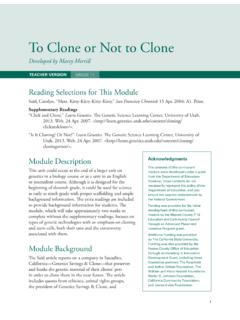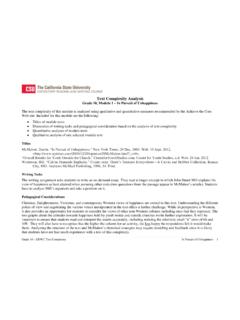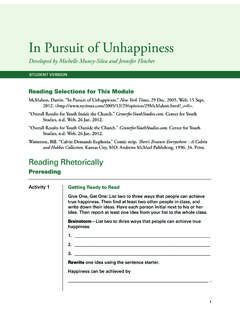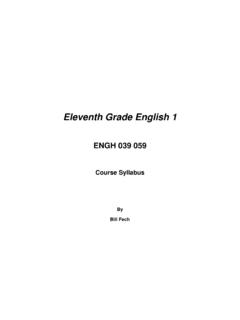Transcription of The Last Meow - Bell English Department
1 The Last meow Developed by Roberta Ching Revised by Roberta Ching and Karen Lopez TEACHER VERSION grade 11. Reading Selection for This Module Bilger, Burkhard. The Last meow . New Yorker 8 Sept. 2003. Web. 5 Jan. 2013. <http://www. >. Module Description The Last meow module is designed for use in the eleventh grade in the second semester. The module introduces students to a sophisticated example of literary nonfiction that features an implied thesis statement illustrated by a wealth of well-researched, factually accurate evidence presented in a lively artistic style. After completing several short writing assignments as part of the module's reading activities, students respond to an on-demand essay topic and then Acknowledgments use that response as the basis for a more formal, text- The contents of this curriculum based academic essay.
2 Because of author Burkhard Bilger's module were developed under a grant unique style, the article, The Last meow , provides an from the Department of Education. However, those contents do not informative, engaging, and thought-provoking look at the necessarily represent the policy of the implications of how we treat our pets. Department of Education, and you should not assume endorsement by the Federal Government. Module Background Funding was provided for the initial development of this curriculum The topic of pets is of interest to students at any grade module by the Merced County P-16. level, but eleventh grade students will benefit from Education and Community Council the reading challenge The Last meow presents and the through an Advanced Placement Incentive Program grant. opportunity the module provides for students to review, hone, and apply reading and writing skills that will serve Additional funding was provided by The California State University.
3 Them well as seniors and later in college. Although at first Funding was also provided by the glance, the length of the article seems daunting, the writer Fresno County Office of Education Bilger has made it manageable by providing breaks in through an Investing in Innovation the text, which divide the article into eight short, self- Development Grant, including these foundation partners: The Rosalinde contained parts that work together like puzzle pieces. and Arthur Gilbert Foundation, The Presented one by one, these chunks of text enable William and Flora Hewlett Foundation, reluctant readers, entice reader interest, ensure close Walter S. Johnson Foundation, California Community Foundation, readings, and encourage meaningful predictions. and James Irvine Foundation. 1. grade 11 TEACHER VERSION. By concluding The Last meow with a series of provocative questions about the costs and benefits of providing cutting-edge medical care to animals, Bilger invites his readers to add their voices to the debate.
4 An interview activity and an essay assignment enable students to realize that, based on personal experiences and observations, they have legitimate credentials to enter such a conversation;. after reading Bilger's research, they are even better prepared to do so. Teachers are encouraged to choose the activities in this module that will best serve the needs and interests of their particular group of students. Because reading The Last meow is the equivalent to studying eight short articles and the writing assignment includes both an on-demand essay and revision and editing to produce a polished final essay, teachers should probably plan to take about four weeks to complete it. Module Objectives In addition to the focus on Common Core State Standards, the module targets the skill areas listed below. Students will be able to Review, hone, and apply reading and writing skills addressed in other ERWC modules they have experienced Employ a variety of reading strategies to tackle eight distinct parts of the article, each written to serve a different rhetorical purpose Read for inference by interpreting the author's implied thesis statement, the implications of the article's title, the rhetorical purpose of each part of the article, and Bilger's purpose for including specific pieces of evidence Make text-based predictions regarding events and main ideas by conducting a close reading of the title and subtitle, individual sentences.
5 And selected chunks of text Use the words of others by participating in authentic writing to learn activities that require students to paraphrase and summarize information in addition to incorporating correctly punctuated direct quotations Demonstrate ability to negotiate voices by participating in a press conference where students assume the alternate roles of both reporter and authority Identify and distinguish the author's use of arguments and counterarguments Model the author's use of different types of evidence by incorporating them in their own writing including facts, statistics, statements from authorities, examples, and personal stories (anecdotes). Complete several short writing assignments to demonstrate understanding of the concepts addressed in the reading section of the module and to generate prewriting that can serve as the basis for both the on-demand essay and revision that conclude the module Write both an essay in response to an on-demand essay topic, and then a revised essay that includes text-based evidence accompanied by citations Note: The activities for students provided in the Student Version for this module are copied here in the Teacher Version for your convenience.
6 The shaded areas include the actual activities the students will see. The use of italics in the shaded areas generally indicates possible student responses and may be interspersed with notes to the teacher that are not shaded. If there are notes to the teacher within the shaded areas, they are indicated by italics and parentheses. 2 | THE LAST meow CSU EXPOSITORY READING AND WRITING MODULES. TEACHER VERSION grade 11. Common Core State Standards for English Language Arts and Reading Rhetorically Literacy Unless otherwise specified, all standards Prereading are for grades 11-12. The strategies in this section of the Getting Ready to Read ERWC are designed to prepare students The Last meow is an example of literary nonfiction: well-researched, in advance of reading factually accurate information presented in a lively, artistic style that both increasingly complex and sophisticated teachers and students traditionally associate with fiction.
7 The first sentence of texts. These brief, the article exemplifies that style: She arrived in Manhattan looking ravaged introductory activities will prepare students and ravishing, like a queen of silent film with one last swoon left in her.. to learn the content of California's Common With this opening line, Birkhard Bilger introduces his readers to a character Core State Standards who plays a prominent role in the article: a cat named Lady who is dying of (CCSS) for English Language Arts (ELA) renal failure. Yet, after reading just the first sentence, a reader would assume and Literacy in the that Bilger was describing an elegant movie star. His use of characterization, sections of the module that follow. imagery, figurative language, word choice, and phrasing is characteristic of the first sentence of a novel. Because of this style, Bilger's article is not only informative and thought-provoking but also engaging.
8 Unlike the articles that students may have read in other modules, The Last meow does not include an explicitly stated thesis statement. Instead, Bilger's article is rich with opportunities to encourage students to read for inference. The author models how to marshal startling facts and statistics; strategically placed, thought-provoking quotations; and examples of compelling anecdotal evidence that are meant to provoke a response from readers while inviting them to interpret his implied thesis statement, which is subtly revealed through Bilger's use of anecdotes, facts, figurative language, quotations, statistics, and word choice. His exemplary use of evidence can serve as a model for students to employ in their own writing in addition to providing a wealth of evidence that they can use to support their opinions in the activities that accompany this module.
9 The activities create the opportunity for teachers to choose ones that will best serve the needs and interests of students. Rather than sharing any of the above information with students right away, introduce them to the concept of literary nonfiction and the text they will be reading by having them complete Activity 1. Activity 1: Getting Ready to Read Quickwrite Read the following sentence: She arrived in Manhattan looking ravaged and ravishing, like a queen of silent film with one last swoon left in her.. Based on reading this introductory sentence, what do you think the text will be about? CSU EXPOSITORY READING AND WRITING MODULES THE LAST meow | 3. grade 11 TEACHER VERSION. What type of text do you think this sentence is introducing fiction or nonfiction? Why? Be prepared to share your ideas as part of a class discussion.
10 When students have completed the quickwrite, ask them to share their answers. Students will usually predict that the sentence introduces a novel or short story based on their recognition of literary devices such as characterization, imagery, figurative language, and word choice. Following this discussion, talk with your students about why the article will be of interest to them and what they can learn from it that will strengthen their own reading and writing as well as broaden their ideas about what constitutes non-fiction writing. The strategies in this section of the Exploring Key Concepts ERWC are designed to prepare students Activity 2 calls for students to work together, as a whole class, to create in advance of reading semantic maps for the words pets, owners, and veterinarians. Project the increasingly complex and sophisticated words and ask students to share words that relate to the three terms.











